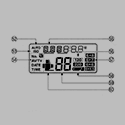|
Saw an article that some motherboard makers have found a way to unlock the non-K series Intel chips so they can be overclocked via the motherboard. https://www.pcgamer.com/motherboard-makers-are-sidestepping-intels-cpu-overclocking-lock/ Is this a good idea for the consumer, and/or does doing so violate the warranty? Just curious.
|
|
|
|

|
| # ? May 30, 2024 21:55 |
|
nnnotime posted:Saw an article that some motherboard makers have found a way to unlock the non-K series Intel chips so they can be overclocked via the motherboard. Intel can't tell if a chips been OCd or not so just dont tell them. Also don't say you enabled XMP if they ask - it's technically OC and they'll deny your claim, GN did a piece on it and it happened to a goon like two weeks ago. Also, it's my understanding that this just forces them to run at boost clocks all the time, still a step up in performance but not a higher clockspeed than it's natively capable of, I could be wrong though, I only skimmed the coverage. Fantastic Foreskin fucked around with this message at 03:04 on May 30, 2020 |
|
|
|
nnnotime posted:Saw an article that some motherboard makers have found a way to unlock the non-K series Intel chips so they can be overclocked via the motherboard. They aren't really "unlocked" as much as TDP is still in the hands of the BIOS... which it has been for all of the Skylake parts. So its not new, its just newly got lovely marketing names attached to it. It only matters for parts that hit TDP limits before other frequency limitations, like the turbo table. So in the 6000 series parts, that was really only the 35w T-series parts that had that issue, and if you were buying a 35w part that normally had a price premium over non-T parts, you prolly didn't really want to bust the TDP in the first place. You probably wanted a 35w part. So TDP busting wasn't really a common practice on Z170. That really changed with the 8700 Non-K. I have an 8700 non-K and a K in my house. At fully Intel settings, the 8700 will run headlong into its 65w TDP limit before any other limit and its performance will crater. The 8700 non-K was very popular with prebuilt systems because of the much lower thermal requirements (aka, they could put dogshit tiny, cheap coolers on em), and a lot of people started to notice how poorly it performed at Intel settings vs the review sites who used the "auto" settings in retail boards that were actually turning the TDP limitations off. An 8700 non-K will perform identically to a stock 8700K with an all core workload with the Intel TDP limitations off. Both will turbo to 4.3 and sit there, both using about 105w. With the Intel TDP limits on, the 8700 will crater to like 3.2ghz and just crawl rear end. That was the genesis for board partners selling TDP busting as a feature. Now with Comet Lake, there are LOADS of parts that have this behavior. Namely, the 10400, 10400T, 10400F, 10500, 10500T, 10600, 10600T, 10700, 10700T, 10700F, 10900, 10900F, and 10900T. All of these will hit that TDP limit before their boost clock, which means all of em will benefit from TDP busting settings. So now we get dumb names like Asus Power Enhancement and Asrock Base Frequency Boost on things their boards have allowed you to do (or they did automatically when you turned the XMP profile on) since 2015. e: I should add that it ALSO means you absolutely SHOULD NOT buy a prebuilt with these CPUs, unless they are actually using a retail board like CyberPower and some others do. And even then, be wary. Cygni fucked around with this message at 03:24 on May 30, 2020 |
|
|
|
Cygni posted:fascinating stuff is it A Thing for people to underclock (undervolt?) or otherwise restrict their systems from running full clip, for the purposes of keeping temperatures in check, as long as they don't mind the performance hit? specifically for Intel, is that something that'd require an unlocked CPU, or is that something that you could do from the motherboard? I guess where I'm coming from is that, having watched that Gamers Nexus video, the thing that stood out to me was this notion that if only the motherboard would run the CPU according to Intel's specs, then the CPU would keep within the advertised TDP, which then means if your cooler is only as good as that advertised TDP (and I'm acknowledging that this is rather fuzzy), then that's how you can keep a CPU happy with a dinky little cooler (again, provided that you don't mind the performance hit). ___ Another question: if the T-version of a CPU can be made to violate its own TDP limits via the motherboard, is that why T-versions are sold to be more expensive, rather than less, because otherwise people would just buy the T-version and then remove the TDP limits and experience a CPU that's as good as a non-T? Also, doesn't this mean that if you bought a T-version CPU, specifically because you want a CPU that doesn't run so hot/doesn't consume so much energy, and then your motherboard has TDP-busting turned on by default, you're kinda getting screwed if you don't know that this is a thing that you need to check?
|
|
|
|
gradenko_2000 posted:is it A Thing for people to underclock (undervolt?) or otherwise restrict their systems from running full clip, for the purposes of keeping temperatures in check, as long as they don't mind the performance hit? Yeah, this is actually super common among laptop users who want to maximize battery life. In a lot of cases there's actual performance gain because laptop chips are trying to stay within a fairly low TDP envelope, and undervolting helps it do that (basically most chips can run at higher clocks/multipliers at lower voltage than they're set to by default, because the default settings are effectively "worst case" settings). Voltage regulation is a per-motherboard thing, and doesn't necessarily need a fully unlocked CPU. You're mostly right about "if mobos didn't juice the gently caress out of the chip, it'd be easier to cool" but the downside is then they wouldn't win the performance bar contest in reviews. So they don't do that. T-versions are more expensive because they can hit higher clocks at a given voltage than others--the entire point is that then you can run them super light on power and still get decent performance. It's effectively a more efficient chip, so you get to pay a premium for that. The leaky "just shove more power into it" silicon is what you get for normal desktop chips. And, yes, if you're trying to keep your power use in check because you want an easy to cool system, and you bought a board that dumps an extra 100+ watts into it, you're gonna think something's massively hosed up if no one clued you in to this issue.
|
|
|
|
gradenko_2000 posted:Also, doesn't this mean that if you bought a T-version CPU, specifically because you want a CPU that doesn't run so hot/doesn't consume so much energy, and then your motherboard has TDP-busting turned on by default, you're kinda getting screwed if you don't know that this is a thing that you need to check? Thats actually a funny question that I have never tested personally. I've got some older S-series and T-series parts from Sandy and Ivy Bridge, but they are all from before this whole TDP thing became a real issue for Intel. With Intel's capacity constraints they haven't really released many (or any?) of the T-series SKUs that would be fun to test that with, like the 8700T and 9900T, to the boxed market. The easiest way to get one of those today is absolutely ebay after they have been pulled from OEM towers coming off lease. You would HOPE that motherboard makers would be smart enough not to blast away their TDPs out of the box... but uh... I honestly don't know! I can tell you with my 8700 Non-K, my Asus Z370 board auto turned on MCE and over volted once I turned on XMP for the ram (yes, this behavior is Dumb and Bad. its part of their AI Tuner crap), and an Asrock board instantly overvolted on first boot without touching anything. The box cooler for the 8700 non-K is one of those hilariously skinny, lovely little circular coolers. Good luck with that at 105w of TDP indefinitely. And lets talk about the 10900T, a true Freak Tier™ CPU. 10 cores, 20 threads, 4.6ghz MaxTurbo, 20mb of L3 on 14nm... and a 35w TDP. lol. Like, it is clearly not even in the realm of reality here. In on one of these boards that feeds way too much voltage and attempts to hold max turbo with no regard to Intel's TDP limit, thats probably going to eat 200w. Hopefully the boards are smart enough to know this is a 35w part nominally equipped with a cooler thinner than a poptart. Thankfully these parts have thermal throttling that keep them from dying even if the settings are dumb, but you are still putting a lot of faith in, as GN reported a few weeks ago, potentially the SINGLE GUY at these board vendors who does ALL of the BIOS coding. Yes, ONE GUY.
|
|
|
|
DrDork posted:T-versions are more expensive because they can hit higher clocks at a given voltage than others--the entire point is that then you can run them super light on power and still get decent performance. It's effectively a more efficient chip, so you get to pay a premium for that. The leaky "just shove more power into it" silicon is what you get for normal desktop chips. By this, you mean that, even though T chips are clocked lower than non-T, if you took a non-T chip and set it to the same clock and the same voltage as a T chip, it wouldn't be stable?
|
|
|
|
gradenko_2000 posted:By this, you mean that, even though T chips are clocked lower than non-T, if you took a non-T chip and set it to the same clock and the same voltage as a T chip, it wouldn't be stable? Potentially, yes. A xxxxT might be able to do, say, 4.0Ghz at 0.95v or whatever, while a xxxxK might need 1.00v to hit 4.0Ghz stable. Intel uses that along with a lower top-line speed to keep overall power use super low compared to normal desktop chips.
|
|
|
|
When people say 'leaky silicon' what does that really mean? Is it that the transistors in the chip in the non-T version have a wider range of threshold voltages, so some low-threshold voltage transistors conduct more current in the off-state than expected (this is the leakage)? And the fact that there are some high-threshold voltage transistors in the distribution means that the chip will either need a little extra time or a little extra voltage for the switching circuits to be able to complete its computations within the clock period? Does this explanation capture the physical differences between non-T & T versions of chips, or is it something else that creates that distinction?
|
|
|
|
silence_kit posted:When people say 'leaky silicon' what does that really mean? Transistors are analog devices so "off" isn't zero volts, the whole operating range of transistors is a curve. Really fast transistors generally let more voltage through even when they are off, and the distance between off and on is smaller allowing them to switch really quickly at the expense of always "leaking" a lot of power. Basically in order to work a high performance transistor needs to be able to quickly change its field strength across the threshold, but the only real way to accomplish that is to have a really weak field because of the capacitance involved in switching. Strong fields that block most or all of the current from passing through also have a lot of capacitance which requires a lot more time to charge or discharge.
|
|
|
|
Indiana_Krom posted:Transistors are analog devices so "off" isn't zero volts, the whole operating range of transistors is a curve. Really fast transistors generally let more voltage through even when they are off ? Do you mean current here? I understand that there often is a trade-off between achieving high transistor on-current density (this is almost the same thing as transistor speed) and low transistor off-current density (this is proportional to static power dissipation in a digital circuit), and the trade-off can be made in digital circuit design when selecting sub-circuits containing transistors with different threshold voltages for the different functions in the circuit. Indiana_Krom posted:and the distance between off and on is smaller allowing them to switch really quickly at the expense of always "leaking" a lot of power. ? Is this just another way of saying that small (meaning short gate length) transistors are susceptible to having unexpectedly low threshold voltage? This effect alone doesn't explain why T-series Intel chip would be faster at a lower supply voltage, though. If you reasoned only using this effect, the T-series Intel chip would have higher threshold voltages, meaning a lower standby power dissipation, but would require more voltage to hit a particular clock speed, because the T-series transistors would need more voltage to get the needed current density for speed. Indiana_Krom posted:Basically in order to work a high performance transistor needs to be able to quickly change its field strength across the threshold, but the only real way to accomplish that is to have a really weak field because of the capacitance involved in switching. Strong fields that block most or all of the current from passing through also have a lot of capacitance which requires a lot more time to charge or discharge. Is this just another way of saying that the way to prevent small transistors from having unexpectedly low threshold voltage is to design the transistor to have a high gate capacitance density? And that in this regime, higher gate capacitance density instead of increasing the current density, like it used to, now leads to lower current density? This effect still doesn't explain why a T-series Intel chip would be faster at a lower supply voltage. This effect by itself would say that the T-series chip would have higher total capacitance and so it would be slower than the non-T series chip, and would require more voltage to run at the same speeds as the non-T series chip.
|
|
|
|
silence_kit posted:? Do you mean current here? silence_kit posted:? Is this just another way of saying that small (meaning short gate length) transistors are susceptible to having unexpectedly low threshold voltage? This effect alone doesn't explain why T-series Intel chip would be faster at a lower supply voltage, though. If you reasoned only using this effect, the T-series Intel chip would have higher threshold voltages, meaning a lower standby power dissipation, but would require more voltage to hit a particular clock speed, because the T-series transistors would need more voltage to get the needed current density for speed. silence_kit posted:This effect still doesn't explain why a T-series Intel chip would be faster at a lower supply voltage. This effect by itself would say that the T-series chip would have higher total capacitance and so it would be slower than the non-T series chip, and would require more voltage to run at the same speeds as the non-T series chip. I'm not sure if they actually make different design selections (gates, etc) in order to optimize the T-series for such low TDP profiles, or if they're just binned; all the reading I've done so far suggest it's the latter, rather than the former. So it sounds like the biggest difference is simple manufacturing variance: the T-chips are the ones that perform better at low voltages than their non-T counterparts. Then Intel slaps a low multiplier max on em to further keep TDP down, and there ya go: 35W parts. e; what most people mean when they talk about "leaky" chips they mean ones that aren't great on the efficiency front compared to their siblings: they need more voltage to be stable at given clocks, and boosting voltage means not only higher power draw during operation, but higher power draw during idle states, too, due to voltage leak. So you end up with a more power-hungry part overall, which is normally fine in desktops and such where the difference of 50W or whatever isn't really that big a deal. DrDork fucked around with this message at 17:34 on May 30, 2020 |
|
|
|
DrDork posted:It isn't necessarily the physical gate length he's talking about, but rather the delta between an "on" and "off" signal. By having less of a delta, more current is "leaking" through while in the "off" state than if the delta were higher, generally speaking. I have heard that transistor on-current/off-current ratio is an important device figure of merit, and that number partially dictates how the digital circuit designers design the chip. If you are using a technology with a high ratio, designs where you have lots of circuitry sitting by idly become more attractive. Or maybe it is more like: portions of the circuit which tend to be used more frequently are more tolerant of a transistor type with a lower on/off current ratio than portions of the circuit which most of the time are not being switched. DrDork posted:e; what most people mean when they talk about "leaky" chips they mean ones that aren't great on the efficiency front compared to their siblings: they need more voltage to be stable at given clocks, and boosting voltage means not only higher power draw during operation, but higher power draw during idle states, too, due to voltage leak. So you end up with a more power-hungry part overall, which is normally fine in desktops and such where the difference of 50W or whatever isn't really that big a deal. I guess I don't understand why this is true. I would think that the chips with higher static power dissipation wouldn't need as much supply voltage to run at a given clock speed. Apparently that is not the case.
|
|
|
|
In pretty much all overclocking videos I've seen that work with liquid nitrogen, people seem to build like a receptacle on top of the CPU, and then they have a cooler or a tumbler full of nitrogen, and then just pour the stuff straight onto the CPU. Obviously the stuff evaporates, so you have to keep pouring more and more in over time, and it's a temporary thing. out of curiosity, is there something like a closed-loop cooling system that uses liquid nitrogen? is that even possible?
|
|
|
|
Kingpin made a setup like that in collaboration with EVGA: https://www.youtube.com/watch?v=9TTqxXxIpPY I remember seeing a video where Steve from Gamers Nexus was interviewing him about it at a trade show where EVGA was showing it off and they discussed some of the drawbacks which included that despite being "closed loop" it would still lose LN2 over time and that it didn't do anything to address the frost/condensation build up you get with subambient cooling (as you can see in that video). Mr.Radar fucked around with this message at 05:28 on Jun 5, 2020 |
|
|
|
Which is frankly overkill and completely insane. For slightly more sane levels of exotic fluid cooling, I think some of us (read: me) are still waiting on DerBauer's entirely-passively-cooled Novec-but-not-actually-Novec thing. https://www.youtube.com/watch?v=AZAUnl37Cr8
|
|
|
|
gradenko_2000 posted:In pretty much all overclocking videos I've seen that work with liquid nitrogen, people seem to build like a receptacle on top of the CPU, and then they have a cooler or a tumbler full of nitrogen, and then just pour the stuff straight onto the CPU. Obviously the stuff evaporates, so you have to keep pouring more and more in over time, and it's a temporary thing. I don't understand how using nitrogen as a working fluid would be a good idea. It's not going to stay cold, and to contain it so it doesn't expand into a gas would surely require incredibly robust.. everything. If you want to get your CPU cold, and keep it cold, very, very cold, you need something that's actively shifting the heat away.. Essentially strap a freezer (phase change cooler) on to your PC. It was semi-popular in years gone by (Prometeia, Vapochill), and was very effective. For the hardcore who think that getting in to the low single digits isn't enough, you need cascade cooling, where one section has a fluid that works to a certain temp, and then another that works at an even lower temp, until you build up a crazy rear end system of essentially freezer-inception that can continuously cool your CPU to negative triple digits.. HalloKitty fucked around with this message at 15:50 on Jun 5, 2020 |
|
|
|
How many GHz can I get if I cool it to absolute zero?
|
|
|
|
all of them
|
|
|
|
gradenko_2000 posted:In pretty much all overclocking videos I've seen that work with liquid nitrogen, people seem to build like a receptacle on top of the CPU, and then they have a cooler or a tumbler full of nitrogen, and then just pour the stuff straight onto the CPU. Obviously the stuff evaporates, so you have to keep pouring more and more in over time, and it's a temporary thing. If it's a closed system, ultimately all the heat needs to go to atmosphere somehow. Atmospheric temperature is way, way too hot for nitrogen to stay in liquid form, so you can't just use a radiator cooled by airflow. (thermodynamics, and whatnot) So you need a cooling system capable of producing temperatures low enough to condense nitrogen. So... you need to have the machinery that produced the liquid nitrogen in the first place, basically.
|
|
|
|
I mean at least some low temperature freezers do use nitrogen as the refrigerant in a closed loop system. I think it's more that doing so at a computer scale is incredibly unrealistic.
|
|
|
|
Liquid nitrogen in a completely sealed container is a really, really bad idea.
|
|
|
|
I wouldn’t gently caress with nitrogen unless I was in a very well ventilated room. Nitrogen leaks are kind of terrifying, all you end up noticing is that you can’t catch your breath. Is the 10th gen i9 going to be worth upgrading from a 9th gen i7? I know that the i7 will be set for ages but that whole 10 cores/20 threads thing is tempting me.
|
|
|
|
Ugly In The Morning posted:Is the 10th gen i9 going to be worth upgrading from a 9th gen i7? I know that the i7 will be set for ages but that whole 10 cores/20 threads thing is tempting me. Unless you have very specific workloads that you know will benefit, no. If you just need more cores, go with something like the 3900X that gets you 12 cores for $100 less than a 10900F. Intel 10th gen doesn't really provide a lot of IPC benefit over 9th gen.
|
|
|
|
Ugly In The Morning posted:I wouldn’t gently caress with nitrogen unless I was in a very well ventilated room. Nitrogen leaks are kind of terrifying, all you end up noticing is that you can’t catch your breath. Meanwhile, in Bitcoin land: https://www.youtube.com/watch?v=Ut8mwo7vGBI Ugly In The Morning posted:
Probably not. Like DrDork said, if you need more cores now get a 3900X (or the 3900XT coming in a month which has a rumored 300MHz base clock bump) or wait for Zen 3 (Ryzen 4000) in Q4 and get a 4900X. If you aren't hurting for cores right now I'd hang on to that system until DDR5 comes to consumer platforms, which will probably be late 2021 or early 2022. Mr.Radar fucked around with this message at 00:44 on Jun 8, 2020 |
|
|
|
Tiger Lake looking pretty competitive all around. Might get me to replace my Ivy Bridge laptop finally. https://twitter.com/_rogame/status/1269796807980310534?s=21
|
|
|
|
Cygni posted:Tiger Lake looking pretty competitive all around. Might get me to replace my Ivy Bridge laptop finally. ....okay, but the 4800U is an 8/16 part @ 1.8GHz/4.2GHz. I really want to hear about some die size comparisons. That will be the deciding factor, I think. Also, hopefully this makes AMD stop their stupid "current gen APUs have last-gen silicon" thing.
|
|
|
|
You know you can just put the whole PC outside in the cold of winter and point a box fan at it. Just run display and USB back into the house.
|
|
|
|
Trying to figure out how the PCIe lanes are routed on this Dell workstation T7400 https://www.dell.com/downloads/global/products/precn/en/precn_t7400_specsheet.pdf Not sure what the chipset that is handling all the PCIe lanes is. The spec'd intel 5400 controller is just a memory controller? There are 2 x16 slots and 1 x4 slot that's x8 physically wide. I'm just curious if the x4 slot is shared with one of the x16 slots and also if the x16 slots are full x16. Plus a bunch of onboard poo poo hardwired in taking up god knows how many lanes as well.
|
|
|
|
Shaocaholica posted:Trying to figure out how the PCIe lanes are routed on this Dell workstation T7400 Huh, that's a blast from the past — I cannot recall offhand what those FSB-based things used to do for PCIe like that. Wasn't the NB the memory controller + PCIe RC, or are those Xeons Nehalems? Also, Apple ARM announcement, INTC stock shrugs it off with a -1% dip. Maybe we'll see ARM MacBooks and x86 MacBook Pro?
|
|
|
|
movax posted:Also, Apple ARM announcement, INTC stock shrugs it off with a -1% dip. Maybe we'll see ARM MacBooks and x86 MacBook Pro? Considering that Intel has been in a "we literally can't make chips fast enough to service demand" situation for years now, this doesn't surprise me from either direction: that Apple would finally cut ties, or that Intel stock doesn't give a poo poo about losing them. And, yeah, I wouldn't be surprised if Apple built a higher TDP version of their Ax ARM chip and basically turned the MacBook into a laptop-format iPad.
|
|
|
|
Isn't that just a (credible) rumor at this point?
|
|
|
|
CFox posted:Isn't that just a (credible) rumor at this point? Technically, but it sounds like basically true and we're just waiting on the official announcement and some further information on how the transition will go: models, timelines, etc. It also matches up with TSMC saying that their 5nm node capacity is already 100% booked. Which itself will be an interesting thing--Apple may be shifting away from Intel and their anemic performance gains just to end up running into TSMC capacity issues (or having to pay $$ to ensure they have the access they need). We shall see. DrDork fucked around with this message at 20:38 on Jun 9, 2020 |
|
|
|
Meanwhile, another vulnerability got disclosed, though Intel found this one, released then retracted it, but it was too late at that point: https://www.phoronix.com/scan.php?page=article&item=crosstalk-srbds-vulnerability&num=1
|
|
|
|
movax posted:Huh, that's a blast from the past — I cannot recall offhand what those FSB-based things used to do for PCIe like that. Wasn't the NB the memory controller + PCIe RC, or are those Xeons Nehalems? You can load those out with dual quad cores running at 3.4ghz. It's Core2/Penryn which was the best core.
|
|
|
|
Shaocaholica posted:It's Core2/Penryn which was the best core.
|
|
|
|
https://newsroom.intel.com/news-releases/changes-intels-technology-systems-architecture-client-group/ Jim Keller has resigned from Intel
|
|
|
|
"personal reasons"?
|
|
|
|
"I, personally, hate this loving place" is a personal reason. I hope it's that rather than a health or family issue.
|
|
|
|

|
| # ? May 30, 2024 21:55 |
|
Keller's been bouncing between jobs every 2-3 years for a while now. I don't think it necessarily means much of anything.
|
|
|






















